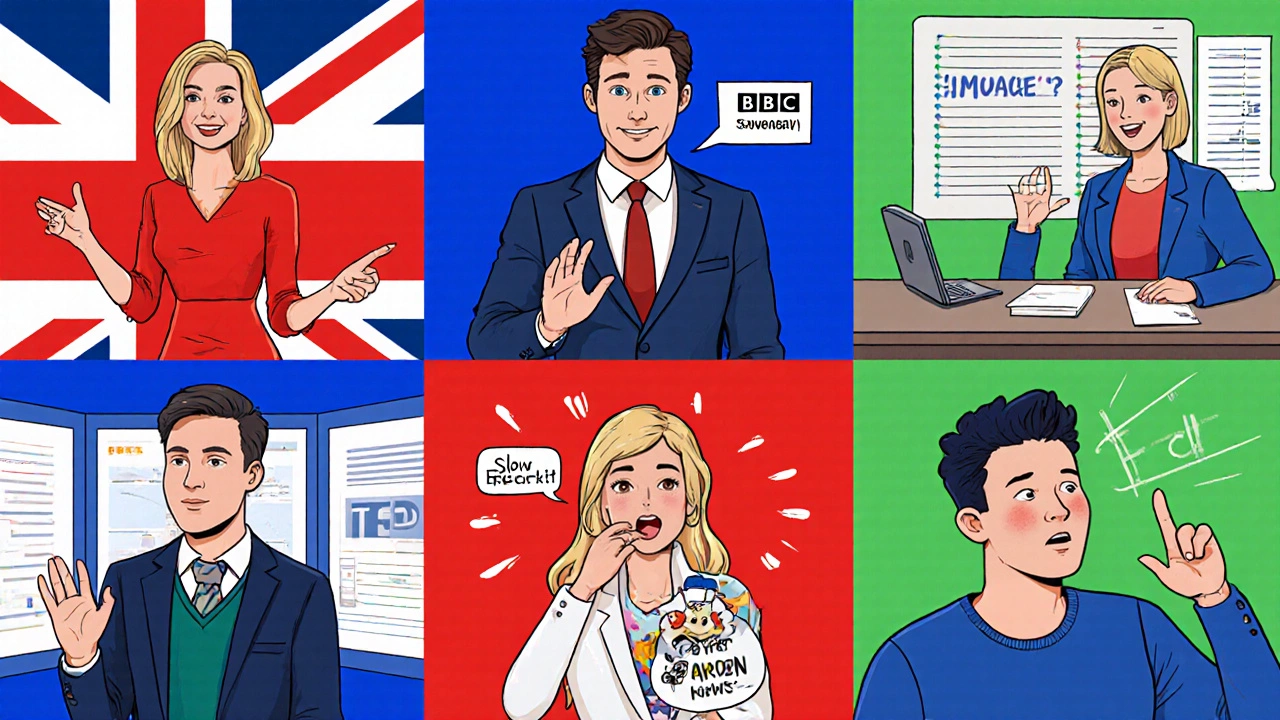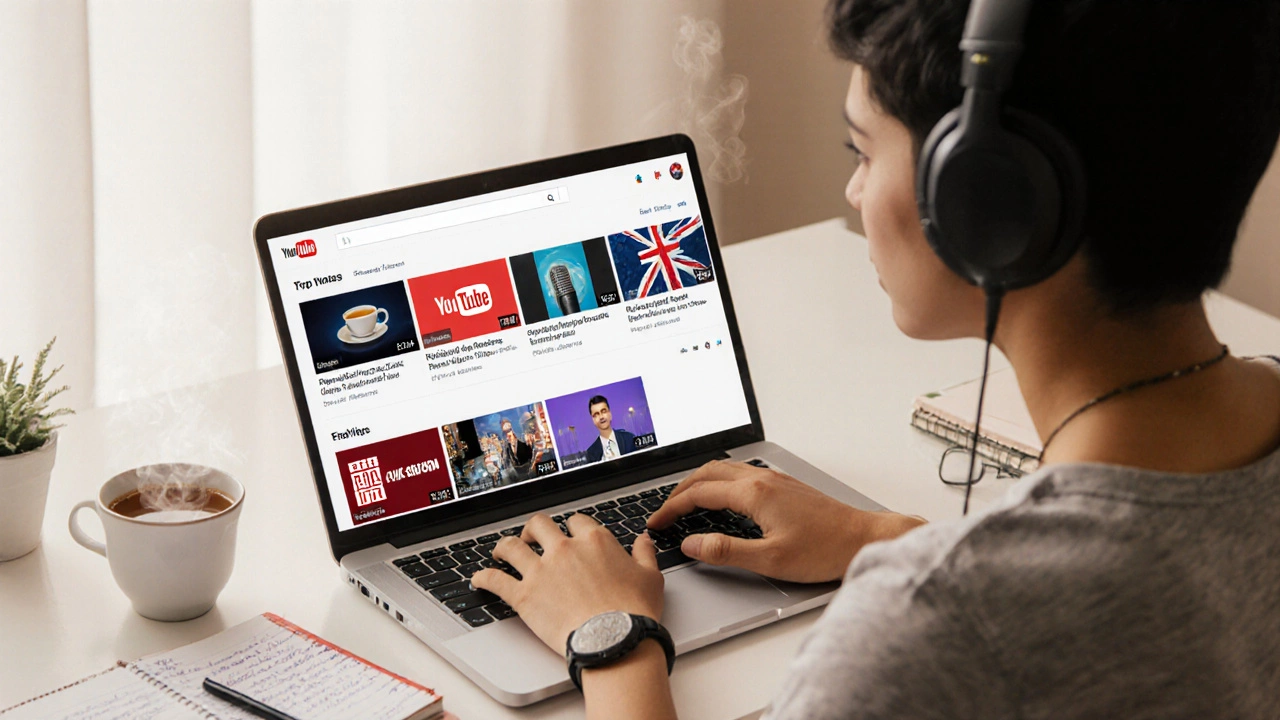When you search for the English learning YouTube channel is a free video resource on YouTube that provides structured English lessons, pronunciation practice, and cultural tips for learners at any level. you’re really looking for a mix of clear explanations, regular uploads, and a teaching style that clicks with you. The good news is that YouTube hosts dozens of creators who spend years fine‑tuning their approach, and most of them are completely free. Below you’ll find a practical roadmap to pick the right channel, a side‑by‑side comparison of the most effective ones in 2025, and tips to squeeze the most learning out of every video.
Key Takeaways
- Choose a channel that matches your current CEFR level and learning goal.
- Consistent upload schedules keep motivation high.
- Channels that blend subtitles, slow‑motion, and interactive exercises work best.
- Mix British and American accents to build flexible listening skills.
- Apply the 80/20 rule: focus on the 20% of content that gives 80% of language gains.
How to Choose the Right Channel
Before you click "Subscribe," ask yourself three quick questions:
- What’s my proficiency? A beginner needs basics like alphabet sounds and simple phrases, while an intermediate learner wants idioms and real‑life dialogs.
- What accent am I targeting? British English, American English, and even Australian English each have distinct vowel patterns.
- How much time can I commit? Some channels release daily 5‑minute clips; others drop a 30‑minute lesson twice a week.
Answering these questions narrows the field dramatically. For example, if you’re a B1‑level learner preparing for the IELTS, a channel that offers exam‑style listening drills and writing tips will be far more valuable than one focused on casual conversation.
Top Channels in 2025
| Channel | Content Focus | Upload Frequency | Target Level | Subscribers (M) |
|---|---|---|---|---|
| English with Lucy is a British‑accent channel that teaches pronunciation, grammar, and cultural nuances. | Pronunciation + Grammar | 3 videos/week | A1‑C1 | 7.2 |
| BBC Learning English is a trusted news‑based channel offering short news‑based lessons and vocabulary. | News & Vocabulary | Daily | A2‑C2 | 4.9 |
| Rachel's English is a American‑accent channel specializing in clear speech, reduction, and listening drills. | American Pronunciation | 2 videos/week | B1‑C2 | 3.6 |
| Learn English with Emma is a interactive channel that mixes role‑play sketches with grammar explanations. | Role‑play + Grammar | 4 videos/week | A2‑B2 | 2.8 |
| VOA Learning English is a US‑government channel delivering slow‑speech news stories for learners. | Daily | Daily | A1‑B1 | 1.4 |
| EngVid is a multi‑teacher platform covering slang, idioms, and exam prep. | Weekly | 7 videos/week | B1‑C2 | 2.1 |
| TED-Ed is a educational channel that pairs animated lessons with subtitles for advanced learners. | Weekly | Weekly | B2‑C2 | 13.5 |
All the channels above meet the best English YouTube channel criteria of consistent uploads, clear audio, and engaged communities. Pick the one that aligns with your answers from the “How to Choose” section, and you’ll have a solid learning partner for the next few months.

What Makes a Channel Effective
Research shows that learners retain 30% more when videos include on‑screen text and interactive pauses. Here’s why the top channels excel:
- Subtitles and transcripts. They let you read while listening, reinforcing spelling and pronunciation.
- Chunked lessons. 5‑ to 15‑minute segments keep attention spans high and fit into busy schedules.
- Progressive difficulty. Each video builds on the previous one, mirroring the natural acquisition curve.
- Community engagement. Comment sections, quizzes, and live Q&A sessions turn passive watching into active practice.
Tips to Maximize Learning from YouTube
- Use the 2‑minute rule. Pause after every sentence, repeat it aloud, and note any new vocabulary.
- Turn on captions. Start with English subtitles, then switch to no captions once you feel comfortable.
- Create a “watch‑list” playlist. Organize videos by theme (e.g., “Business English” or “Pronunciation”) so you can revisit specific topics.
- Leverage the speed control. Slow down challenging sections to hear each phoneme, then speed up as you improve.
- Combine with spaced‑repetition apps. Export new words to Anki or Quizlet for long‑term retention.

Common Pitfalls to Avoid
It’s easy to fall into habits that waste time. Watch out for these traps:
- Passive binge‑watching. Clicking “play all” without note‑taking leaves you with little actual progress.
- Skipping subtitles. Jumping straight to audio can overwhelm beginners and cement mispronunciations.
- Sticking to one accent only. While immersion is good, exposure to multiple accents improves overall comprehension.
- Ignoring community resources. Many channels offer attached worksheets; skipping them means missing valuable practice.
Next Steps
Pick one channel that fits your level, subscribe, and set a realistic schedule-maybe two 10‑minute videos per day. After a week, review your progress: can you understand the main idea without subtitles? If not, keep using captions and add a second channel for variety. Within a month, you should notice smoother listening and more confidence speaking.
Remember, YouTube is a supplement, not a replacement for real conversation. Pair video study with language‑exchange apps, short writing exercises, or a local speaking club. The combination of visual input and live practice is the fastest route to fluency.
Can I learn English only with YouTube?
You can make great progress, especially for listening and vocabulary, but speaking fluently still needs real‑time interaction. Pair YouTube with language‑exchange partners or a tutor for best results.
How many videos should I watch each week?
Aim for 3‑5 short lessons (5‑15 minutes each) spread across the week. Consistency beats binge‑watching once a month.
Are subtitles necessary for intermediate learners?
Yes, at first. Turn them on to catch new words, then gradually turn them off to train listening without visual cues.
Which channel is best for IELTS preparation?
BBC Learning English and EngVid both offer dedicated IELTS listening and writing tutorials. Combine them with official practice tests for comprehensive prep.
How can I track my progress on YouTube?
Create a spreadsheet noting video title, duration, new vocabulary, and a self‑rating of comprehension. Review it monthly to see improvement trends.
